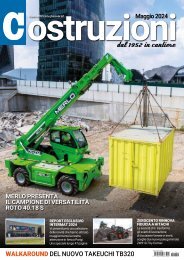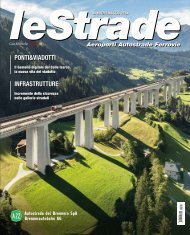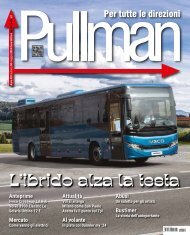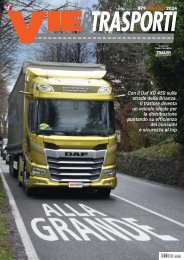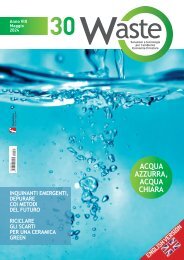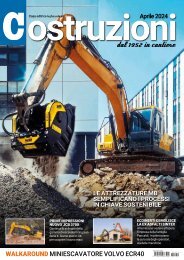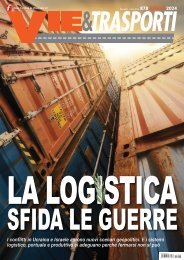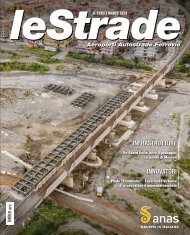leStrade n. 1956 aprile 2024
INFRASTRUTTURE Milano Serravalle Milano Tangenziali La sicurezza in tempo reale GALLERIE La Realtà Virtuale “avanza” nelle gallerie BBT
INFRASTRUTTURE
Milano Serravalle Milano Tangenziali La sicurezza in tempo reale
GALLERIE
La Realtà Virtuale “avanza” nelle gallerie BBT
- No tags were found...
Create successful ePaper yourself
Turn your PDF publications into a flip-book with our unique Google optimized e-Paper software.
Modellazione FEM e digital twin<br />
I gemelli digitali impiegati per il monitoraggio dei<br />
manufatti della rete autostradale consentono un<br />
continuo scambio di informazioni tra il dominio fisico<br />
della struttura reale e il dominio virtuale del<br />
modello di simulazione ingegneristica. Questi “simulation-based<br />
digital twins” integrano, infatti,<br />
degli accurati modelli agli elementi finiti, sviluppati<br />
fedelmente sulla base della documentazione<br />
esistente, considerando l’esatta geometria,<br />
le proprietà termomeccaniche, e le varie fasi di<br />
costruzione e tensionamento che hanno avuto<br />
luogo durante lo sviluppo delle singole opere ed<br />
eventuali successivi interventi di ampliamento o<br />
rinforzo strutturale.<br />
In una modellazione per fasi, ogni componente<br />
strutturale viene aggiunto al modello in step<br />
successivi, partendo da uno stato di stress e spostamento<br />
nullo, analogamente a come avviene<br />
durante la costruzione reale. Le simulazioni tengono<br />
in considerazione effetti non lineari dipendenti<br />
dal tempo quali viscosità (fluage) e ritiro<br />
del calcestruzzo.<br />
Il comportamento nel tempo di ogni elemento<br />
strutturale dipende dalla sua effettiva data di<br />
installazione. Tenere in considerazione tali effetti<br />
è fondamentale per descrivere correttamente<br />
il comportamento anelastico della struttura,<br />
e in particolare l’interazione tra elementi<br />
strutturali installati in periodi differenti (per<br />
esempio, negli interventi di ampliamento del<br />
viadotto dei Parchi o del viadotto Tortona). La<br />
modellazione tiene inoltre conto delle proprietà<br />
termo meccaniche dei materiali utilizzati, permettendo<br />
di descrivere gli effetti indotti da variazione<br />
di temperatura.<br />
Prendendo come riferimento il modello FEM realizzato<br />
per il viadotto dei Parchi, in analogia con<br />
le procedure di calcolo eseguite in fase di progettazione<br />
dell’opera, viene analizzato il comportamento<br />
combinato di tre campate successive,<br />
modellando accuratamente le interazioni tra<br />
le stesse.<br />
L’impalcato, le pile e le fondazioni sono stati modellati<br />
utilizzando elementi finiti di tipo brick a 20<br />
nodi con funzioni di forma quadratiche. Le barre<br />
Dywidag e i tiranti di tensionamento sono stati<br />
modellati utilizzando specifici elementi in grado<br />
di sostenere puramente azioni assiali.<br />
Il modello è stato sviluppato per poter supportare<br />
differenti altezze delle pile, in accordo con<br />
quanto effettuato in fase di progettazione e con<br />
le caratteristiche reali dell’opera. In particolare,<br />
sono stati creati modelli per pile di altezza di 7,5,<br />
12,5 e 17,5 metri.<br />
Fig. 6: Confronto tra<br />
il viadotto Forlanini<br />
e il suo gemello digitale.<br />
Fig. 6: Comparison between<br />
the Forlanini viaduct and<br />
its digital twin.<br />
Fig. 7: Confronto tra<br />
il viadotto dei Parchi<br />
e il suo gemello digitale<br />
(vista laterale).<br />
Fig. 7 : Comparison between<br />
the Parchi Viaduct and its<br />
digital twin (side view).<br />
Fig. 8: Calibrazione mediante<br />
analisi inversa.<br />
Fig. 8: Calibration through<br />
inverse analysis.<br />
Al fine dell’esecuzione delle verifiche secondo<br />
normativa e del calcolo del coefficiente di utilizzo<br />
della struttura, le azioni interne vengono calcolate<br />
dalla piattaforma mediante integrazione<br />
numerica degli stress degli elementi brick tridimensionali.<br />
L’analisi delle misure<br />
A partire dal modello iniziale, è caratteristica fondamentale<br />
del gemello digitale la possibilità di<br />
adattare le sue proprietà sulla base dell’effettivo<br />
comportamento della struttura, identificando<br />
prontamente l’insorgere di eventuali danni.<br />
L’obiettivo del gemello digitale è di minimizzare<br />
automaticamente la discrepanza tra il modello<br />
di calcolo ed i dati misurati, al fine di ottenere<br />
una affidabile valutazione dello stato tensionale<br />
della struttura, sulla base della sua intera storia<br />
di carico, e del suo comportamento in corrispondenza<br />
di carichi agenti.<br />
Il gemello digitale effettua quindi l’aggiornamento<br />
e la calibrazione automatica del modello sulla<br />
base dei dati di monitoraggio che vengono continuamente<br />
acquisiti. La soluzione utilizza delle<br />
tecniche avanzate per analisi inversa in tempo<br />
reale (real-time back-analysis) per la calibrazio-<br />
ne del gemello digitale, volte a minimizzare la<br />
discrepanza tra i dati misurati dai sensori installati<br />
sull’opera, e i risultati delle simulazioni numeriche.<br />
In particolare, la piattaforma esegue<br />
in automatico, ed in continuo, procedure di calibrazione<br />
al fine di identificare qualsiasi parametro<br />
strutturale incognito (o per il quale ci sia<br />
una significativa incertezza) che governi i risul-<br />
English Version<br />
Discrete sensors<br />
Different series of sensors were applied to the structures,<br />
with positions varied from time to time depending<br />
on the static scheme and constraint characteristics,<br />
always consisting of thermometers, triaxial accelerometers,<br />
displacement transducers and biaxial inclinometers<br />
(fig. 3).<br />
More precisely, triaxial accelerometers with MEMS<br />
technology were used, with a measurement range between<br />
± 2 g, a frequency band between 0 and 500 Hz,<br />
and a spectral noise level between ± 22.5 μg/Hz^0.5;<br />
MEMS technology biaxial inclinometers with measurement<br />
range of ± 15°, resolution of 0.001°; Potentiometric<br />
displacement transducers with measuring range<br />
0÷150 mm and precision of 0.05 mm.<br />
In general, the accelerometers and inclinometers were<br />
positioned along the lateral edges of the decks in correspondence<br />
with the on-axis sections and at the quarters<br />
of the spans, on top of the piers the inclinometers<br />
and displacement transducers were provided to measure<br />
the rotations and displacements of the supports,<br />
finally the thermometers were installed to detect the<br />
temperature in the entire area of interest of the structures.<br />
The sensors were wired and connected to a satellite<br />
synchronization device and to a local control unit (UCL)<br />
which manages all the elements for the connection of<br />
the optic fiber transmission BUS, the acquisition of data<br />
from the field sensors, their organization into databases<br />
and preparation for sending them to the cloud.<br />
The “Viadotto dei Parchi” and the distributed<br />
optic fiber sensors (DOFS)<br />
The “Viadotto dei Parchi” is the most important work on<br />
the eastern ring road of Milan (A51). The original project,<br />
signed by the engineer Silvano Zorzi, dates back to 1970<br />
and presents a typical structure consisting of a deck plate,<br />
continuous and integral with the piers, with spans of 24<br />
m, with a zero-moment point imposed, for each span, at<br />
7 m from the pier axis, and materialized by a Gerber type<br />
saddle. The two motorway carriageways are supported<br />
by two viaducts having the characteristics described and<br />
parallel to each other with a distance between centers of<br />
approximately 29 ÷ 30 m, with a total length of approximately<br />
3,000 m.<br />
In 1992, in conjunction with the construction of the third<br />
lane of the Eastern Ring Road of Milan, the structures of<br />
the viaduct were also enlarged. The distance between the<br />
two viaducts made it possible to create two new structures,<br />
one for each carriageway, in the internal space between<br />
the two existing ones (fig. 4).<br />
The considerable length and number of spans of the work<br />
suggested the adoption of a system of distributed fiber<br />
optic sensors (DOFS) for the acquisition of temperature,<br />
deformation, and vibration measurements.<br />
These sensors are distinguished from the “discrete” optic<br />
fiber ones, often used for measurements on road structures<br />
and bridges, generally based on fiber Bragg gratings<br />
(FBG). These devices measure punctual deformation using<br />
a spectroscopic technique and are usually used in chains<br />
of a few dozen points. For this reason, they can only meas-<br />
Infrastrutture&Mobilità<br />
42 4/<strong>2024</strong> <strong>leStrade</strong><br />
<strong>leStrade</strong> 4/<strong>2024</strong> 43







